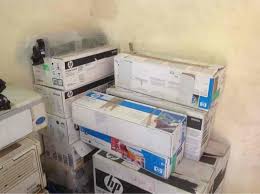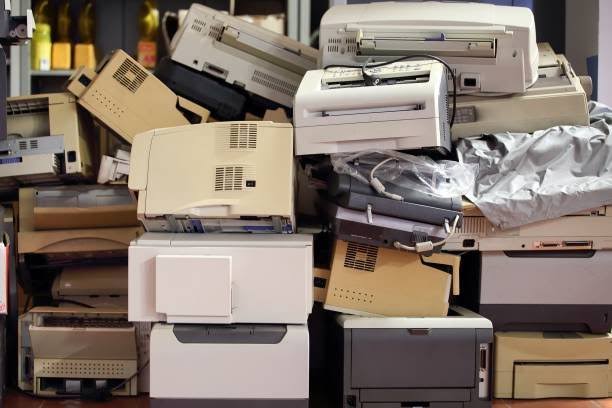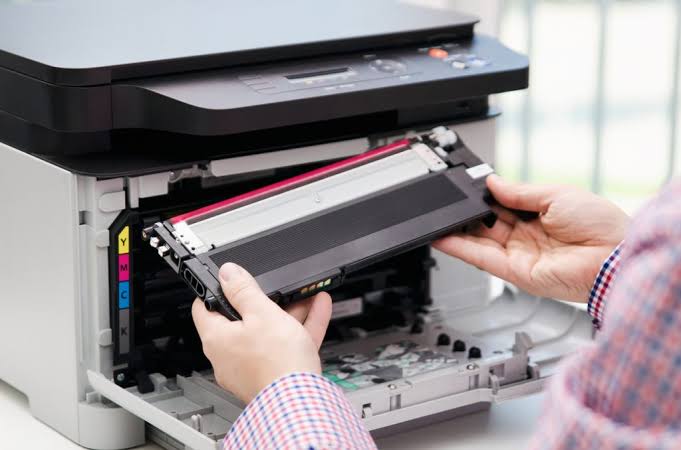Printer Cartridges Wastes can be transformed into new printer cartridges. This means that instead of throwing away old printer cartridges, they can be recycled and used again. This helps to reduce waste and protect the environment. When printer cartridges are thrown away, they often end up in landfills where they can take hundreds of years to decompose. This can lead to pollution and harm to animals and plants.
By recycling printer cartridges, we can help to conserve natural resources. The process of making new printer cartridges from old ones involves melting down the plastic and other materials and then reshaping them into new cartridges. This saves energy and reduces the need for new materials to be extracted from the earth.
Many companies now offer recycling programs for printer cartridges. These programs make it easy for consumers to return their old cartridges for recycling. Some companies even offer incentives, such as discounts on new cartridges, for participating in these programs.
In addition to recycling printer cartridges, there are other ways to reduce waste in this area. For example, using refillable printer cartridges can help to cut down on the amount of waste generated. Refillable cartridges can be filled with ink or toner multiple times before they need to be replaced, reducing the need for new cartridges.
Overall, converting printer cartridges wastes into new printer cartridges is a simple but effective way to help protect the environment. By recycling old cartridges and reducing waste, we can all do our part to create a more sustainable future.
Read Also: The Ultimate Guide to Unlocking the Potential of Garbage Wastes
Types of Recyclable Printer Cartridges Wastes and their Uses

There are several types of recyclable printer cartridge wastes, each with its own uses and benefits.
1. Inkjet Cartridges: Inkjet cartridges are commonly used in home and office printers. These cartridges contain liquid ink that is sprayed onto the paper to create images and text. Once empty, inkjet cartridges can be recycled by refilling them with new ink or by breaking them down into their component materials to create new cartridges.
2. Toner Cartridges: Toner cartridges are used in laser printers and photocopiers. These cartridges contain a fine powder called toner, which is fused onto the paper to create images and text. Toner cartridges can be recycled by refilling them with new toner or by breaking them down into their component materials for reuse.
3. Drum Units: Drum units are another component of laser printers and photocopiers. These units transfer the toner onto the paper and must be replaced periodically. Drum units can be recycled by refurbishing them for reuse or by extracting valuable materials for use in new products.
4. Fuser Units: Fuser units are responsible for melting the toner onto the paper. Like drum units, fuser units need to be replaced over time. These units can be recycled by refurbishing them or by extracting metals and other materials for reuse.
5. Print Heads: Print heads are found in inkjet printers and are responsible for spraying the ink onto the paper. When print heads become clogged or worn out, they need to be replaced. Print heads can be recycled by refurbishing them or by extracting valuable materials for reuse.
Recycling these types of printer cartridge wastes, we can reduce the amount of waste sent to landfills and conserve valuable resources. Additionally, recycling printer cartridges helps to minimize the environmental impact of printing and contributes to a more sustainable future.
How to Convert Printer Cartridges Wastes into New Printer Cartridges

Converting printer cartridge wastes into new printer cartridges involves several steps:
1. Collection: The first step is to collect used printer cartridges. This can be done through various means, such as participating in recycling programs offered by printer manufacturers, dropping off cartridges at designated recycling centers, or working with third-party recycling companies.
2. Sorting: Once collected, the printer cartridges are sorted based on their type and condition. This helps in determining the best method for recycling or refurbishing each cartridge.
3. Cleaning: Next, the cartridges undergo a cleaning process to remove any remaining ink, toner, or debris. This ensures that the cartridges are ready for refurbishing or recycling.
4. Refurbishing (Optional): Some cartridges may be suitable for refurbishing, where they are disassembled, inspected, and repaired if necessary. This may involve replacing worn-out components, such as seals or springs, and refilling the cartridges with ink or toner.
5. Material Recovery: For cartridges that cannot be refurbished, they are disassembled further to recover valuable materials. Plastic components, such as casings and cartridges bodies, are separated and processed for recycling. Metals, such as aluminum or steel, are also recovered and sent for recycling.
6. Manufacturing: The recovered materials are then used in the manufacturing of new printer cartridges. Plastic resins are melted down and molded into cartridge casings, while metals are melted and formed into new components. These new cartridges may contain a combination of recycled and virgin materials, depending on the manufacturer’s specifications.
7. Quality Control: Before being packaged and distributed, the newly manufactured cartridges undergo rigorous quality control checks to ensure they meet industry standards and perform reliably.
The Benefits of Converting Printer Cartridges Wastes into New Printer Cartridges
Converting printer cartridges wastes into new printer cartridges offers numerous benefits:
1. Environmental Protection: Recycling printer cartridges helps to reduce the amount of waste sent to landfills, thereby conserving valuable landfill space and reducing pollution. It also reduces the need for extracting raw materials, such as plastic and metals, from the earth, leading to lower energy consumption and fewer greenhouse gas emissions.
2. Conservation of Resources: By reusing materials from old cartridges, the need for virgin materials is reduced. This conserves natural resources such as oil (used in plastic production) and metals (used in cartridge components), contributing to a more sustainable and environmentally friendly manufacturing process.
3. Energy Savings: Recycling printer cartridges consumes less energy compared to producing new cartridges from scratch. The energy required to collect, sort, clean, and process recycled materials is often lower than the energy needed to extract, refine, and manufacture virgin materials.
4. Cost Savings: Recycling printer cartridges can result in cost savings for both consumers and manufacturers. Consumers may benefit from lower prices on recycled cartridges compared to brand new ones, while manufacturers can save on production costs by using recycled materials instead of purchasing virgin ones.
5. Job Creation and Economic Benefits: Recycling and refurbishing printer cartridges create jobs in the recycling industry, contributing to economic growth and stability. Additionally, by reducing the demand for virgin materials, recycling helps to stabilize prices and reduce dependence on volatile commodity markets.
6. Promotion of Corporate Responsibility: Companies that implement recycling programs for printer cartridges demonstrate their commitment to environmental stewardship and corporate social responsibility. This can enhance their reputation and brand image among consumers who prioritize sustainability.
7. Extended Product Lifespan: By refurbishing and recycling printer cartridges, their usable lifespan is extended, reducing the need for frequent replacements. This not only saves money for consumers but also reduces the overall environmental impact associated with manufacturing and disposing of new cartridges.
Overall, converting printer cartridges wastes into new printer cartridges is a win-win solution that benefits the environment, conserves resources, saves energy, reduces costs, creates jobs, and promotes corporate responsibility.
Read Also: How To Fix a Garbage Disposal Jam
The Uses and Benefits of Recycled New Printer Cartridges

Recycled new printer cartridges offer several uses and benefits:
1. High-Quality Printing: Recycled new printer cartridges undergo stringent quality control measures to ensure they meet or exceed industry standards. As a result, they deliver high-quality prints comparable to those produced by brand new cartridges.
2. Cost-Effectiveness: Recycled new printer cartridges are often more affordable than brand new cartridges, making them a cost-effective option for consumers and businesses. This cost savings can be particularly significant for high-volume printing operations.
3. Environmental Sustainability: By using recycled materials, new printer cartridges help conserve natural resources and reduce environmental impact. They divert waste from landfills and reduce the need for virgin materials, leading to lower energy consumption and greenhouse gas emissions.
4. Promotion of Circular Economy: Recycled new printer cartridges contribute to the circular economy by extending the lifespan of materials and reducing waste. This sustainable approach to manufacturing and consumption helps create a more resilient and resource-efficient economy.
5. Support for Recycling Programs: Purchasing recycled new printer cartridges supports recycling initiatives and encourages companies to invest in more sustainable practices. This, in turn, helps promote greater adoption of recycling programs and reduces reliance on finite resources.
6. Wide Compatibility: Recycled new printer cartridges are designed to be compatible with a wide range of printer models and brands, ensuring versatility and ease of use for consumers. They offer plug-and-play functionality, making them convenient alternatives to brand new cartridges.
7. Reduced Environmental Footprint: By choosing recycled new printer cartridges, consumers and businesses can reduce their environmental footprint and contribute to global efforts to combat climate change and preserve natural ecosystems.
8. Regulatory Compliance: Many governments and organizations around the world are implementing regulations and incentives to promote recycling and reduce waste. Using recycled new printer cartridges helps companies comply with these regulations and demonstrate their commitment to sustainability.
Overall, recycled new printer cartridges offer a compelling combination of performance, affordability, and environmental responsibility. By choosing recycled options, consumers and businesses can support a more sustainable future while enjoying reliable printing solutions.
The Challenges of Converting Printer Cartridges Wastes into New Printer Cartridges and their Solutions
Converting printer cartridges wastes into new printer cartridges presents several challenges, along with potential solutions:
1. Contamination: Printer cartridges often contain residual ink or toner, which can contaminate the recycling process and affect the quality of the recycled materials.
Solution: Implement thorough cleaning processes to remove contaminants before recycling. Advanced technologies, such as specialized cleaning solutions and equipment, can help ensure the purity of recycled materials.
2. Complexity of Materials: Printer cartridges are composed of various materials, including plastics, metals, and electronic components, which can be challenging to separate and recycle effectively.
Solution: Invest in innovative separation and sorting technologies to streamline the recycling process. Advanced sorting techniques, such as automated sorting systems and material identification technologies, can enhance efficiency and accuracy.
3. Design Complexity: Some printer cartridges are designed with intricate structures or proprietary components, making disassembly and recycling more difficult.
Solution: Advocate for standardized cartridge designs that prioritize ease of disassembly and recyclability. Collaboration between manufacturers, recyclers, and industry stakeholders can facilitate the development of eco-friendly cartridge designs.
4. Limited Consumer Awareness: Many consumers are unaware of the importance of recycling printer cartridges or may lack access to convenient recycling facilities.
Solution: Educate consumers about the benefits of recycling printer cartridges and provide accessible recycling options, such as collection programs at retail locations or mail-in recycling services. Promote environmental awareness through marketing campaigns and partnerships with community organizations.
5. Economic Viability: Recycling printer cartridges may be economically challenging due to fluctuating commodity prices and the cost of recycling technologies.
Solution: Explore innovative business models, such as extended producer responsibility (EPR) programs or product stewardship initiatives, to incentivize manufacturers to take responsibility for the end-of-life management of their products. Government incentives and subsidies can also support the development of sustainable recycling infrastructure.
6. Regulatory Compliance: Compliance with environmental regulations and recycling standards can be complex and resource-intensive for manufacturers and recyclers.
Solution: Stay informed about evolving regulatory requirements and industry best practices. Invest in compliance management systems and environmental certifications to demonstrate commitment to sustainable practices and ensure adherence to legal obligations.
Frequently Asked Questions (FAQs) About How to Convert Printer Cartridges Wastes into New Printer Cartridges
Here are some frequently asked questions (FAQs) about how to convert printer cartridges wastes into new printer cartridges:
1. What are printer cartridge wastes?
Printer cartridge wastes refer to used or empty printer cartridges that are no longer usable for printing. These cartridges may contain residual ink or toner and are typically discarded after reaching the end of their lifespan.
2. Why is it important to convert printer cartridge wastes into new cartridges?
Converting printer cartridge wastes into new cartridges helps reduce waste sent to landfills, conserves natural resources, and promotes environmental sustainability. It also supports the circular economy by extending the lifespan of materials and reducing the need for virgin resources.
3. How are printer cartridge wastes converted into new cartridges?
Printer cartridge wastes are collected, sorted, cleaned, and refurbished or recycled. Refurbishing involves repairing and refilling cartridges for reuse, while recycling involves breaking down cartridges into component materials for manufacturing new cartridges.
4. What types of printer cartridges can be converted into new cartridges?
Various types of printer cartridges, including inkjet cartridges, toner cartridges, drum units, fuser units, and print heads, can be converted into new cartridges through refurbishing or recycling processes.
5. Can recycled new printer cartridges match the quality of brand new cartridges?
Yes, recycled new printer cartridges undergo stringent quality control measures to ensure they meet or exceed industry standards. They deliver high-quality prints comparable to those produced by brand new cartridges.
6. Where can I recycle my printer cartridge wastes?
Many printer manufacturers offer recycling programs for their cartridges, allowing consumers to return used cartridges for recycling. Additionally, third-party recycling centers and retailers may also accept printer cartridges for recycling.
7. What are the benefits of using recycled new printer cartridges?
Recycled new printer cartridges offer cost-effectiveness, environmental sustainability, support for recycling programs, wide compatibility, reduced environmental footprint, and compliance with regulatory requirements.
8. Are there any challenges associated with converting printer cartridge wastes into new cartridges?
Yes, challenges include contamination, complexity of materials, design complexity, limited consumer awareness, economic viability, and regulatory compliance. However, these challenges can be addressed through innovative solutions and collaborative efforts.
Read Also: Importance and Types of Pets
